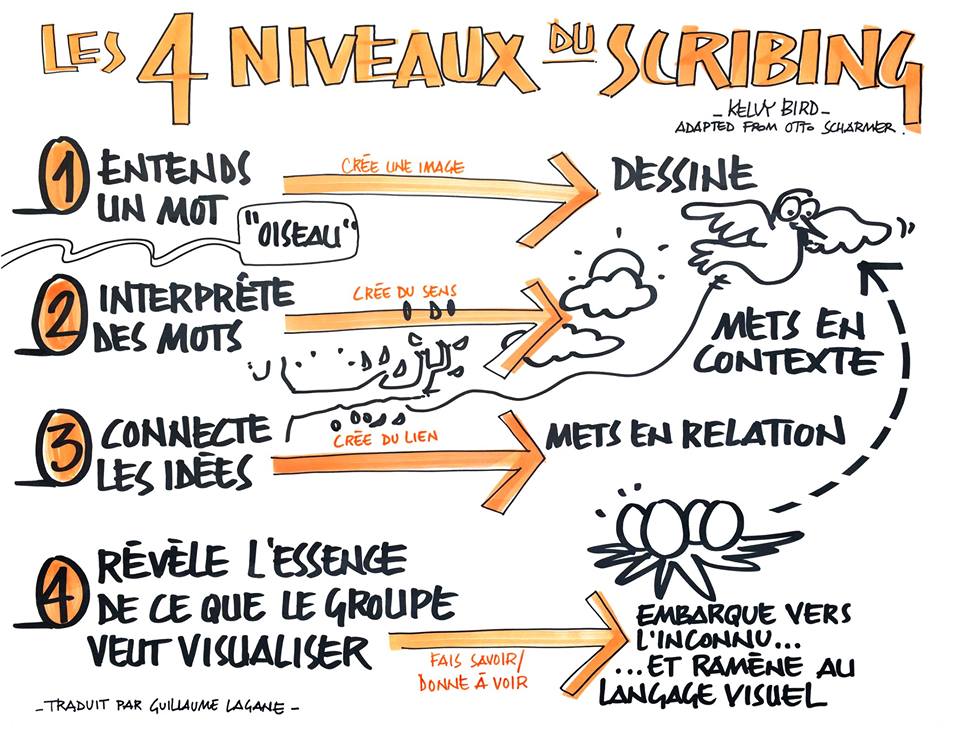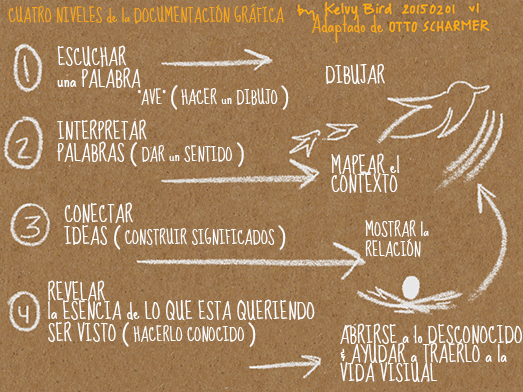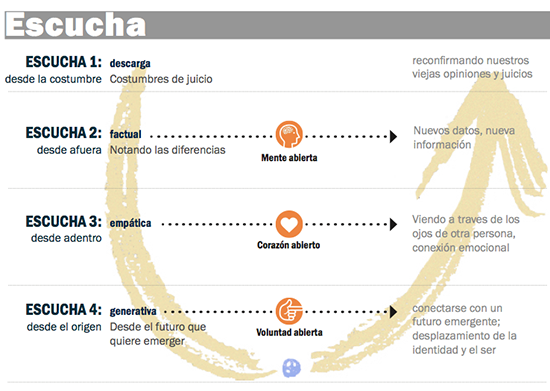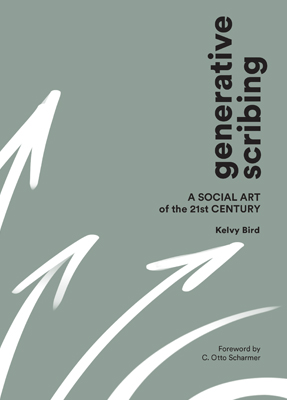
There exist depths, or phases, of scribing that directly correlate with attention.
Different “levels” of listening can help us participate in a shift of awareness and possibility. Otto Scharmer has described four levels of listening: (1) downloading; (2) factual listening; (3) empathic listening; and (4) generative listening. I apply each level of listening to the visual practice of scribing, as depicted above.
Level one scribing: Mirror – hear a word and make a picture.
We use level one listening, “downloading,” to reconfirm and reflect what we already know.
Our drawing is literal; someone says “bird” and we draw a bird. I also refer to this as “object-oriented” scribing, where a focus on individual, named parts is the primary approach. We track largely at a data level, naming the literal words, and draw in areas on a page in a somewhat isolated manner.
Level two scribing: Differentiate – interpret words and make sense.
Use level two listening, “factual listening,” to notice differences and data that disconfirm what we think we already know.
In scribing, we interpret what is being spoken from a broader vantage point. We still draw what we hear, but our lens expands to make sense of what is being said in a factual context, which we can diagram. The bird is flying; then it reaches the coast and joins a flock. At this level we enter the domain of storytelling. We might draw the literal scene, or mind map to organize data into information.
Level three scribing: Connect – relate ideas and make meaning.
We use level three listening, “empathic listening,” to see a situation through the eyes of another, to make an emotional connection. We get out of our own skin, step back, and get added perspective that helps us direct our attention to the entirety of a person or situation.
This is where containers are activated, where our own heart comes online, where we feel. We start to care, genuinely care, and our stance shifts. Our drawing shifts (how can it not?!) as it comes, literally, from a deeper place in our body. Not only the head and the hand are in motion, but the entire torso is engaged in our output.
We realize the story in the room is coming from a cultural frame of reference beyond the room; the facts coming out have causal underpinning. No bird, no story, exists as an island. Something came before the lone bird flying, and something will come after. We could connect the scenes of (1) a lone bird flying with (2) a bird reaching the coast—and by establishing that relation show the bird’s path.
We shift from noticing moments in time to sensing movements over time. As we inquire, we start to inhabit the story and make sense of it on an expanded scale. What happens between the bird taking flight and the bird landing? What was the bird’s behavior along the way? What influences, such as weather or predators, did it encounter?
Level four scribing: Surface – reveal what wants to be seen.
Using level four listening, “generative listening,” we connect with our capacity to let go and let come an emerging future possibility that reveals more fully who we are and who we want to be.
In level four, or generative, scribing we sense and uncover the highest potentiality for the systems we serve. This requires being sensitive not only to the content that is obvious and clear, but also to the content that is fuzzy, blurred, faint—small tones of hesitancy in a speaker’s voice, long pauses between words, coughing that subtly interrupts a sentence.
In level four scribing, we connect with source, and with social and energetic fields. We listen to voices in the room. We also have our full selves open and receptive to all kinds of sensory and intuitive inputs: rain on the roof, a fly buzzing around someone’s juice cup, the freshness or staleness of the air, the quality of being of the presenter and other participants (at ease, jittery, highly focused . ..), the light, the shadows—a sort of pulse in the air.
Here we might inquire into the space around the bird along its entire path. Why is it flying alone? Is it seeking its flock? Where will the flock go next? Will it stay intact? What is the season? What is its health?
To understand how to apply these levels more concretely, simply replace “bird” with “business plan,” “flying” with “management process,” “coast” with “quarterly profits,”
“flock” with “strategic plan,” “predators” with “competition,” “weather” with “economic climate,” and “calling” with “vision.” And then imagine what drawing or facilitating those aspects of a conversation would be like.
Match the level of scribing to the needs of the situation.
I would not show up for a summer picnic wearing a down jacket and carrying snowshoes. Likewise, I would not expect to exercise generative scribing in a thirty-minute introduction, where three people had eight minutes each to set up their content expertise. Different settings require different approaches. And each level of scribing has a value and relevant application.
Level one scribing is great for conferences where presentations are short and multiple people share their thoughts in bursts. (See Generative Scribing appendix Figure 22.)
Level two scribing is useful for panel discussions, academic lectures, negotiations, strategic planning, even system mapping. (See appendix Figure 23.)
Level three scribing is relational, emphasizing the interaction between elements. It’s a useful approach in storytelling, dialogue, culture mapping. (See appendix Figure 24.)
And with level four scribing, we draw what must be drawn in the developing reality, representing the absolute present moment as it unfolds, in right time. (See appendix Figure 25.) It’s useful in ongoing large-scale change initiatives, cross-sector and multi-stakeholder settings, contexts of societal transformation.
中國 – Español – Français
Related posts: Listening, the Iceberg, Storytelling, and Decoding a Wall
Otto Scharmer, Levels of Listening, as found in Theory U: Leading from the Future as it Emerges, first edition, Society for Organizational Learning, 2007 and a video clip from u.lab here: https://www.youtube.com/watch?v=eLfXpRkVZaI. As reference, Otto’s model – and yes, we scribe while listening, also in these levels…..

French translation, from Guillaume Lagane of Facilitation Graphique

Chinese translation, from Jayce Lee

“It was such a honor and delightful experience to have a quick chat over email with Kelvy, when I found out she wrote an article about the 4 levels of scribing last week. It is truly a gift to all of us. For me, as a scribe, as a visual learner, it is a golden opportunity to reset myself from ground zero once again, to not only focus on the art of listening, but to deeply appreciate and practice the 4 levels of scribing.”
備註:為尊重著作權如需使用本文章請註明原始出處
4 Levels of Scribing 視覺記錄的四個層次
常常有人問我們視覺記錄師是如何做我們在做的事?我有個簡短的解答:「你們講,我們畫」然而有另一種方式來思索,所以接下來我試著開始表達我粗略的思考.這篇文章會稍微有點短,可是我希望透過它來將這個思考發展到一個地步.
參考奧托夏莫聆聽的四層次架構(詳見文章末)運用在圖像記錄,我對於視覺記錄我有了以下的演譯:
在一個層次,我們姑且稱之為第一層次,我們聽到什麼就畫什麼,就是字面上的表述。有人說 “鳥”我們就畫隻鳥。在另一個層次,第二層次,雖然還是畫出我們所聽見的,但是我們從一個更寬廣的觀點來看見被說出來的是什麼意思.我們可以更廣角的鏡頭來觀察、傾聽、覺察,我們可以讓被說出來的內容以有意義的佈局方式呈現出其情境.例如:有人形容在展開圖中的鳥兒:“一隻正在翱翔的鳥,飛近海岸線並且飛入群鳥之中”,此時我們就進入故事敘述範疇當中.
接著在第三層次,我們所進行圖像記錄的這家公司,在探索實施新策略時,僱用新人需要付出什麼代價。我們領悟到在鳥,鳥群,海岸線的樣貌,與這家公司的狀態之間的連結- 這是一個展示字面上意義與隱喻兩部分關聯的機會,而這兩部分有著類似性質的能量.也許這兩部分的連結會被及時顯現出來–也許過幾個小時後才會被顯現出來。然而兩者間卻都彼此息息相關,我們(視覺記錄師)注意到了這一部分,因此我們能夠選擇用一個更廣闊的觀點來呈現。我們藉由加上一個鳥巢和鳥蛋來勾勒出情境,也許也可以加入一些文字來表達正在轉變的意義。
這樣的能量在第三層次中開始變得具體.然後當你做這工作越久,會越領悟到,實際上有些東西正開始發生…我們的傾聽會更新、更深,同時我們開始放下需要畫的渴望。在第四層次到來的時候,我的體驗是一個視覺記錄工作者必須願意很深層的接納並願意與正在發生的能量有親密的融合.這時會發現時間變緩慢了,空氣變凝靜了,在長時間的停頓中(參與者說話較少時)說出來的話語來自更深層的內在,人們不再只是為自己說話而是為更大的整體而表達出來.(蛻下小我,沒有誰是強勢的,僵化的觀點也煙消雲散。就好像是種突破性的創新正在發生,有些事正在生成,有些事變得更鮮活,而身為視覺記錄者的我們,見證了這個過程.某種程度像是一位助產士一般,透過我們的手和我們的存在狀態引導著這一切的發生,以心領意會的方式見證正在發生的共同轉變。
因此,很關鍵的是,讓自己成為一個管道。只須勾勒出新生命中需要被畫出來的部分,只畫出能代表當下的那個純粹時刻。
(針對這個主題還有非常多可以寫,我會繼續寫)是的,當我們視覺記錄工作者在記錄時也能以這幾種層次傾聽著,所以也可參考奧托的模型.
Translated by Jayce Lee , Proofread by Ripley Lin
4 niveles de la documentación gráfica, traducción al español por Zulma-Pataleta

Con frecuencia la gente pregunta cómo hacemos lo que hacemos. Hay una respuesta corta: “Dibujamos mientras la gente habla…” Y también hay otra forma de pensar en nuestra labor que hasta ahora estoy empezando a descubrir. Este artículo será corto, pero quisiera poner a andar las ruedas y aterrizar las ideas.
Considerando el marco de 4 niveles de escucha de Otto Scharmer‘s (ver al final del artículo) propongo la siguiente traducción aplicada a la documentación gráfica:
En el primer nivel, llamémoslo N1 (Nivel 1) dibujamos lo que oímos de manera literal, alguien dice “AVE” y nosotros dibujamos un ave. A otro nivel, N2, vemos lo que se está diciendo desde un punto más amplio, todavía dibujamos lo que oímos, pero nuestra lente puede ser expandida para entender lo que se está diciendo dentro de un contexto que podemos mapear. Alguén describe un ave en una imagen expandida “mientras que el ave va volando, llega a la costa y se une a una bandada de aves,” y entramos entonces al dominio del storytelling (contar historias).
Luego en N3, nos damos cuenta de que hay una conexión entre el ave, la bandada y la forma de la linea costera y la forma en la que la compañía – para la cual estamos haciendo documentación gráfica – está explorando lo que se requiere para atender a los nuevos empleados mientras se desarrolla una nueva estrategia (de una parte anterior de la conversación.) Aquí tenemos una oportunidad para demostrar la linea entre las partes de dos elementos de contenido que han sido compartidos: uno metafórico y otro literal pero de similar energía. Tal vez estos elementos fueron mencionados al mismo tiempo, tal vez fueron mencionados con horas de diferencia, pero ellos están RELACIONADOS, y nosotros lo notamos y tal vez podamos decidir mostrar aún una visión más amplia. Generamos sentido a través de añadir un nido, un huevo y tal vez anotando lo que está empezando a evolucionar.
Y luego hay algo más que es cada vez más evidente entre más hagas este trabajo… realmente es una manera profunda de escuchar combinada con soltar incluso la necesidad de dibujar. En ventanas de N4, mi experiencia es que el documentador debe asumir una unión íntima con la ENERGÍA de lo que está sucediendo, una energía que comienza a ser tangible en N3, en la que el tiempo se hace más lento, el aire reposa y las palabras salen del corazón en medio de largas pausas, con un tono de sintiéndose representados por la postura de unos pocos. (El ego se ha replegado. Ninguna voz domina. Las agendas se han evaporado. ) Se trata de una ruptura creativa en la que algo está naciendo, algo esta llegando a la VIDA y nosotros, como documentadores gráficos lo presenciamos; de alguna manera somos parteras facilitando a través de nuestro ser y nuestras manos el surgimiento de un cambio y CONOCIMIENTO colectivo.
Aquí lo que es importante es ser un canal. Solamente dibuja lo que debe ser dibujado en la nueva realidad. Solamente representa el momento absolutamente presente.
(Hay MUCHO MÁS que escribir sobre esto, y lo haré) Como referencia el modelo de Otto – y si, nosotros documentamos mientras escuchamos también en estos niveles…

 Today’s great challenges call us to (re)arrange our interior dimensions to more adequately meet current, external realities. Working from the inside out, by unpacking my professional experience over the past thirty years, I propose that “generative scribing” is one practice to aid with this larger cultural and personal transition.
Today’s great challenges call us to (re)arrange our interior dimensions to more adequately meet current, external realities. Working from the inside out, by unpacking my professional experience over the past thirty years, I propose that “generative scribing” is one practice to aid with this larger cultural and personal transition.




